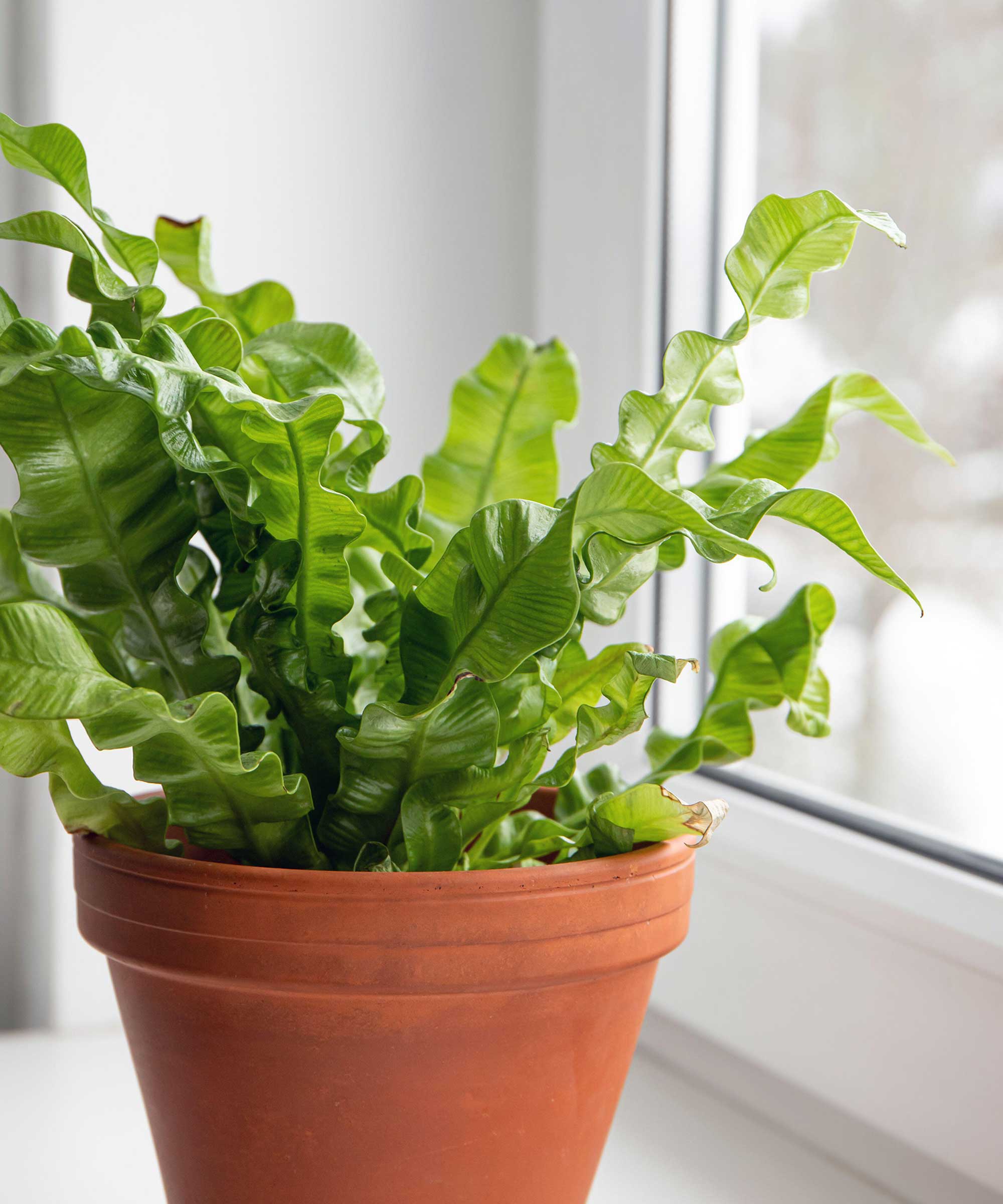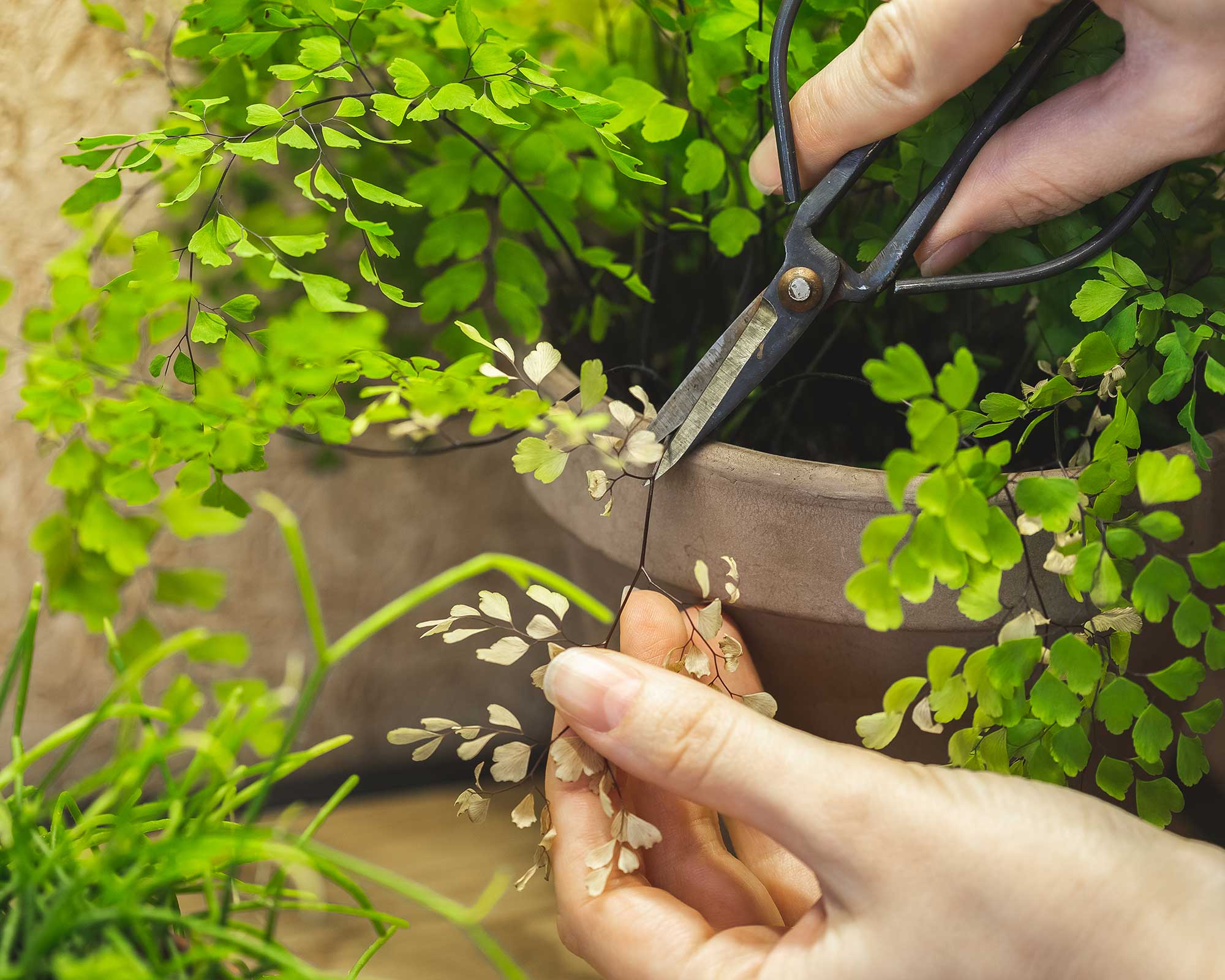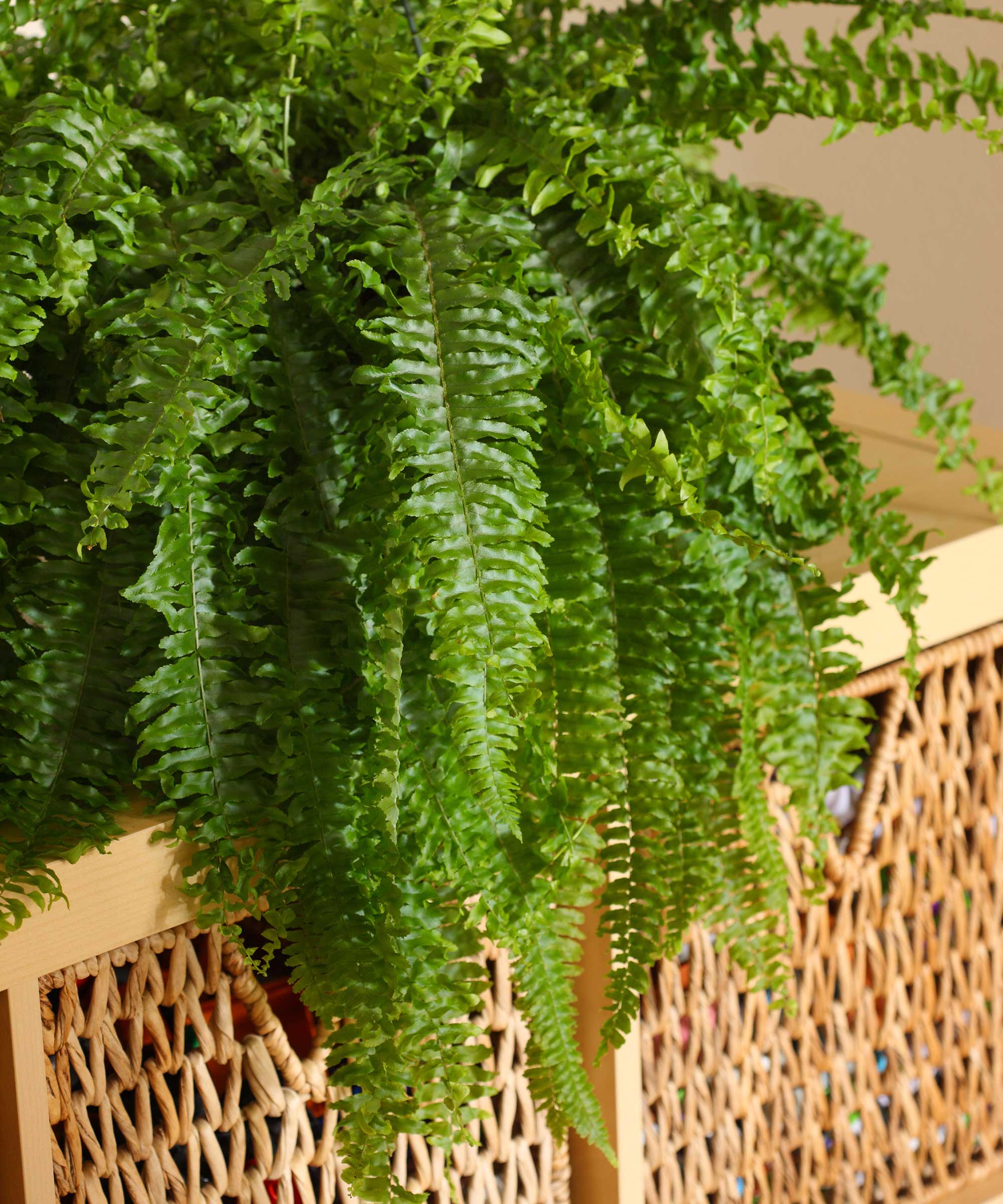
- 1. Use the right soil
- 2. Consider location carefully
- 3. When to plant
- 4. Water regularly
- 5. Keep humidity up
- 6. Prune when needed
- 7. Consider propagation
- What to shop
- FAQs
- Should you repot ferns?
- What are some recommended ferns for indoor growing?
- What are some recommended ferns for outdoor growing?
- Meet our experts

Learning how to care for ferns is worthwhile for indoor and outdoor gardeners alike. These fabulous plants instantly give a courtyard, patio, or bedroom shelf a luscious and leafy look. And once you've got to grips with the essentials, they're fuss-free.
We chatted with plant-care professionals to get the lowdown on exactly what ferns need to look their best. Below, they share their expert insights, including insight on watering, planting location, pruning, and more.
Whether you want to grow ferns alongside other beautiful indoor plants or are interested in adding them to your yard, this guide is for you.
How to care for ferns, according to plant experts
There are thousands of fern species. These include evergreen and deciduous types, compact ones that make great houseplants for small spaces, bronze-tinted ones, and delicate, feathery ones. Take time to explore your options to find the perfect variety for your space.
1. Use the right soil

Nastya Vasylchyshyna, a botany expert from Plantum, says, "The potting mix for your fern should be fertile, loose, and well-draining. Make sure to always plant ferns into containers with drainage holes at the bottom so that they don’t get waterlogged."
This houseplant soil mix from Perfect Plants Nursery is a good option for the job, as it includes perlite, which improves drainage. This mix is suitable for caring for other houseplants, too.
You can also grow potted ferns outdoors in containers. Again, use a well-draining mix, such as Miracle-Gro's potting mix from Amazon.
Growing ferns in your garden borders? According to Michael O'Brien, the owner of Hommes + Gardens, ferns planted in the ground outdoors prefer moist, rich soil. Nastya recommends amending the planting hole by introducing about two inches of compost to it. "Mix it evenly into the soil," she says.
2. Consider location carefully

Getting the location right is key when learning how to care for ferns. Kiersten Rankel, a plant expert from Greg, says, "Most ferns thrive in bright, indirect light indoors, such as near an east- or north-facing window." This is similar to when caring for fiddle leaf figs and many other houseplants.
Kiersten continues, "Outdoors, they love shady, cool spots under trees or on the north side of your home. Ferns in sunnier spots will need attention and water more often."
Plant them in areas with good air circulation, but protection from drying winds, Kiersten advises. It's always worth double-checking the tag before you decide where to put your fern, as some have slightly different preferences.
3. Plant at the right time

Spring is a great time to integrate ferns into your backyard ideas. Nastya recommends planting them only once the weather becomes reliably warm and the danger of frosts has passed, giving them time to establish before fall.
Spring is also the optimal time for replanting an indoor fern into a fresh soil mix. "That’s when ferns begin their active growing period and can recover from repotting stress more quickly," Nastya says.
4. Water regularly

Kiersten says, "When it comes to watering, indoor ferns prefer consistently moist soil but not soggy conditions. Check the top inch of soil and water when it feels dry."
According to Nastya, indoor ferns need watering about three times a week. "When it’s hot, they may even need a drink every other day," she says. A moisture meter, available from The Sill, can make it easier to gauge when to water your houseplants.
"Outdoor ferns also like evenly moist soil," Kiersten continues. "Water deeply when the top couple of inches dry out and mulch around the base to retain moisture." Nastya adds that it’s especially important to water outdoor ferns consistently for the first few months after planting.
Michael recommends using an irrigation system equipped with a dripline to help ensure consistent moisture for your outdoor ferns. We like the look of this 100ft dripline from Dig at Amazon, which has great customer reviews.
"However, it's still beneficial to give them a gentle spray from above with a hose," Michael continues. "When using the hose, aim the spray towards the base of the plant to water the soil directly, avoiding wetting the foliage.
"For the best results, water your ferns in the morning. This allows any excess moisture to evaporate during the day, reducing the risk of fungal diseases."
Getting the watering right is an essential part of how not to kill houseplants and plants outdoors. Nastya says, "Frequent underwatering will result in the fronds turning yellow and drying out, as well as the plant looking wilted overall. On the other hand, regular overwatering and waterlogging will induce root rot and dieback. A characteristic sign of excess moisture is the blackening of young fronds’ tips."
5. Keep humidity up

On the topic of H2O, ferns also love a good amount of humidity. Those grown indoors may need a bit of a helping hand to get conditions just right. "Aim for 50% or higher," Kiersten says.
Michael recommends placing a humidifier nearby or grouping your ferns together. "Alternatively, you can place a shallow tray filled with water and pebbles beneath the plant to increase humidity," he says.
You can also mist your plants regularly, suggests Kiersten. We like this stylish brass mister from the Sill, which can be used when caring for Chinese money plants, too.
6. Prune when needed

Michael notes how regular trimming of dead or yellowing fronds promotes new growth and maintains the plant's appearance. Remove these at the base, Kiersten says.
Outdoor deciduous fern foliage will naturally turn brown every year as winter approaches. This can be cut right back, either in late fall or early spring. New spring growth will follow.
You'll need a clean and sharp pair of pruners for the job — these Gonicc pruners from Amazon have more than 19,000 five-star ratings. You can use them to remove dead leaves when caring for peace lilies, too.
7. Consider propagation

It's possible to propagate ferns to get new plants for free. This can be very tempting once you know how to care for ferns and how simple it can be.
Kiersten explains that it can be done by dividing mature indoor plants. Gently tease apart the root ball and place sections in fresh soil, she instructs.
"Many outdoor ferns spread naturally by underground rhizomes, so you can dig up a section with roots and plant it elsewhere," she adds. This is also a good way to control their spread if they are beginning to outgrow their space.
Looking for more ways to expand your plant collection? Consider propagating a fiddle leaf fig, if you have one, too.
What to shop

Price: $8.99
Pair this on-trend macrame hanger with a pot and add your favorite fern for an instant indoor update. Perfect for bringing a boho-chic vibe to your space.

Price: $22.99
A favorite fern of many, this Boston fern is 1–2ft tall and wide and comes in a hanging basket to easily brighten a corner of your home.

Price: $21.99
This 2.5-liter humidifier from Pharata will help keep humidity levels up around indoor ferns and other tropical plants. Plus, it includes an ambient night light.
FAQs
Should you repot ferns?
Repotting plants is a key part of houseplant care. It prevents their roots from becoming congested, which makes it difficult for them to absorb the nutrients they need to thrive. Plus, it provides a chance to refresh the potting soil. Kiersten recommends repotting every one to two years in the spring, using a slightly larger pot.
Keep an eye on outdoor ferns in container gardens as well. They, too, need repotting from time to time to help maintain healthy growth.
What are some recommended ferns for indoor growing?
Both Nastya and Kiersten recommend Boston ferns. "They can handle a missed watering or two and aren't super fussy about humidity," Kiersten says. Nastya adds that planting them into hanging pots is a great way to add a tropical touch to your space.
If you're tempted by these easy-care houseplants, Boston ferns are available to shop from Lively Root.
Nastya continues: "Asplenium and adiantum ferns are also good picks for growing as houseplants. "These are elegant and attractive plants that, provided with proper care, will grow plenty of lush and dense foliage."
These include the bird's nest fern (Asplenium nidus), the brittle maidenhair fern (Adiantum tenerum), and the venus hair fern (Adiantum capillus-veneris).
Then there are the staghorn ferns, again available at Lively Root, which Nastya says are rather unusual-looking. They typically have shallow and relatively small root systems, so you can grow them attached to vertical surfaces, she says. "You’ll need to either mist the plant regularly or immerse the growing support in water to give your fern a drink."
What are some recommended ferns for outdoor growing?
There are both hardy and tender ferns available for growing outdoors, so be sure to choose varieties that suit your location and climate.
Nastya recommends large and woody species like the Australian tree fern or the Mexican tree fern. "They’ll look great both standalone and grouped together."
They need lots of space to grow and develop properly, she adds. Make sure to avoid planting them in open locations, as prolonged exposure to direct sun will scorch and dry out their foliage.
Other options, suggested by Kiersten, include the tough and adaptable lady fern, the cinnamon fern, or the Japanese painted fern. "They can handle the brighter sun outdoors without wilting," she says.
The Japanese painted fern is available to buy from Nature Hills, and has silvery-green foliage with purple stems. Growing up to 18 inches in height, it's a good option for small backyards.
Meet our plant experts

Nastya is a professional botany expert for the Plantum app that helps identify plants and plant diseases and provides care recommendations. Her specialization is plant morphology, phytopathology, and plant physiology.

Prior to moving to LA, Michael lived in New York where space for an edible garden was only a dream, and the idea of gardening as a career seemed outlandish. Little did he know that when he designed his first edible garden on the side of his house on the driveway, it would lead to becoming a certified organic gardener who now designs and maintains gardens for clients around LA, as well as offering plant placement consultations.

Kiersten Rankel is a certified Louisiana Master Naturalist and regularly volunteers with local community gardens and nonprofits to help restore critical ecosystems along the Gulf Coast. In her spare time, she enjoys tending to her 150+ houseplants and vegetable garden.
If you're looking for a flowering shrub to accompany your backyard ferns, consider learning how to grow hydrangeas, which also thrive in shady spots. Indoors, you could grow a money tree alongside these leafy beauties to enhance the botanical vibe.
Join our newsletter
Get small space home decor ideas, celeb inspiration, DIY tips and more, straight to your inbox!

The garden was always a big part of Holly's life growing up, as was the surrounding New Forest, UK, where she lived. Her appreciation for the great outdoors has only grown since then; over the years, she's been an allotment keeper, a professional gardener, and a botanical illustrator. Having worked for Gardeningetc.com for two years, Holly now regularly writes about plants and outdoor living for Homes & Gardens. In her spare time, Holly loves visiting local English gardens and is particularly fond of relaxed cottage-garden schemes. She also loves prairie-style planting – the tapestry effect of grasses mixed with drought-tolerant blooms never ceases to delight her. Always happiest around plants, when she isn't swooning over gardens, she's looking after her ever-growing collection of houseplants and arranging seasonal flowers in her apartment to paint.